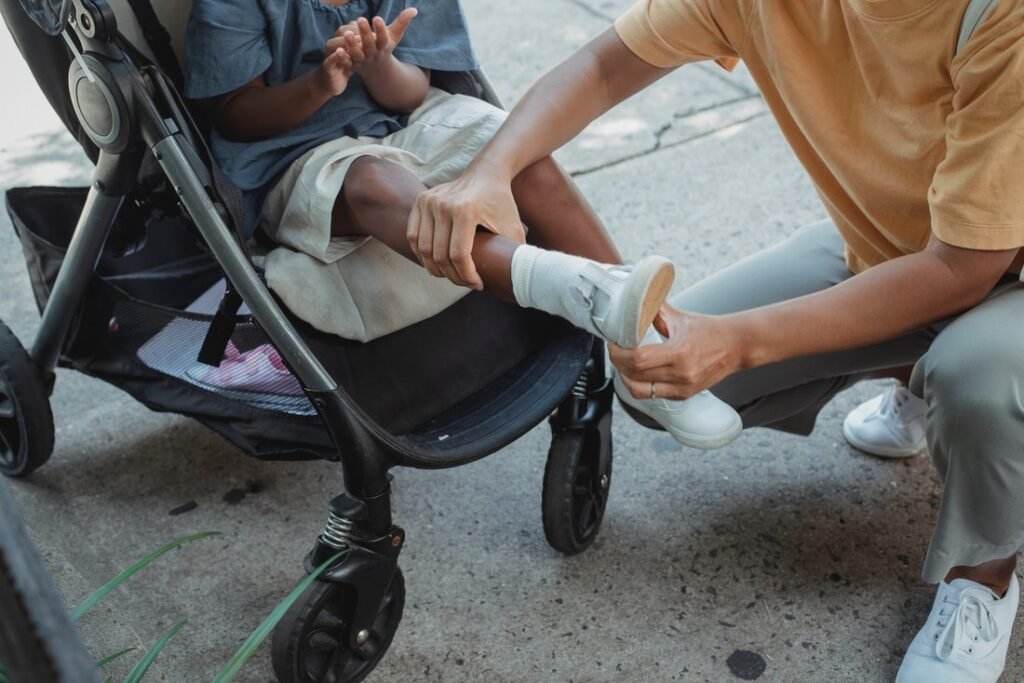
During the ages of 1-5, toddlers tend to be excited, enthusiastic, and full of energy, meaning there is always a lot of jumping and running around. Thus, this is also when they most need comfortably fitting footwear, a challenge for most parents since infant and adult shoe sizes are not measured on the same scale.
Furthermore, children are constantly growing at this age which makes an estimated shoe size last not more than a few months.
What is the average shoe size of a two-year-old?
Keeping aside any sizing differences due to varying brands, one can expect the average shoe size of a two-year-old to be between US 6-8.
This converts to UK 5-7, EU 22-24, AU 5.5-7.5 MX 13-15, and JP 14-16 in different sizing systems.
It is important to note that not all children have the same growth rate; therefore, these are only the probable ranges.
How to size toddlers’ shoes?
While there is no harm in picking out a size from the average range, parents looking for a perfect fit could opt for measuring the length of their children’s feet to get an exact number. This could be done in either of the two ways provided below.
Measuring Tape Method
 Considered both reliable and easy, this method entails that the parent measures the length of the sole of their child’s feet from toe to heel using a tape measure.
Considered both reliable and easy, this method entails that the parent measures the length of the sole of their child’s feet from toe to heel using a tape measure.
It is best to have both parents around, just in case the toddler starts to get fidgety or excited.
Another way to do this is to lay out the tape measure touching the wall and have the child stand against the wall. The latter is found to be more efficient since it also measures the back of the heel.
Paper Method
The paper method happens to be more direct and less time-consuming. It involves the child putting their foot on a piece of paper while the parent draws an outline of their foot with a pencil or marker.
This can then be used as a guide to measure the length of the foot with a ruler or tape measure. Some may argue that the drawn outline is not an exact measure and may be larger than the feet.
However, that can provide an appropriate size to fit the toddler comfortably.
What factors should be considered when buying footwear for a toddler?
The following are a few factors that need to be accommodated for after measuring children’s feet so that parents can pick out the right pair:
Room for Socks
When buying shoes, it is best to consider leaving out space for socks, especially since most parents prefer their children to wear socks with their shoes. It is also better to measure their feet with socks on so they can pick out a size that leaves some room for socks.
Moreover, it is generally better to pick a size large enough to offer some wiggle room. This takes into consideration their growth rate and makes the shoes last them much longer.
Feet Swelling
During early years, after a few hours of walking and standing, children’s feet tend to swell up, which is why measuring them first thing in the morning or immediately after they wake up is not a good idea.
It is best to wait till the afternoon when they’ve had a chance to move around a bit so that the size you get is comfortable even after they’ve walked or stood in them for a couple of hours.
Get Their Opinion on It
While a lot of toddlers are not that communicative, they do tend to express discomfort almost immediately. It is best to make them simply wear the shoes during the shopping trip and have them walk around in them.
Parents can look out for signs of excitement, like children running around in them or if they seem uncomfortable in the shoes. Children should also be trusted with color or design choices when they are old enough to do so.
What are some tips to remember when shoe shopping for your toddler?

- It is important to measure both feet since there may be a slight size difference between them. This helps parents get a bigger size to accommodate the larger foot.
- As a last-minute estimation, doubling the kid’s age in years and adding 2 for a boy and 1 for a girl could get one pretty close to the shoe size they’re looking for. This method is suggested for children only up to five years.
- Measuring their feet close to the shopping trip is very important because a gap of even a few weeks could result in a growth spurt.
- Most available sizing charts provide average shoe sizes according to age, but it is necessary to keep individual growth rates in mind.
- Some brands or manufacturers may have unfamiliar sizing systems in place. Thus, it is best to tag your toddler along when shoe shopping and make them try the pair on.
Conclusion
Shoe shopping for a toddler may be just as stressful as parenting a jumpy ball of excitement, but if you keep in mind the above helpful tips and factors, it should go like a breeze.
Granted, this age does involve them growing out of clothes and shoes way too quickly, but if it means letting your child have fun while being comfortable, going back for the correct size shouldn’t be a hassle.



